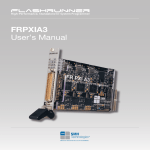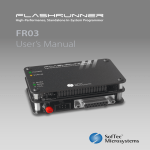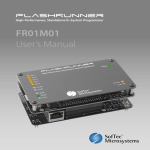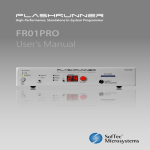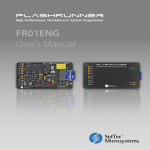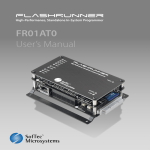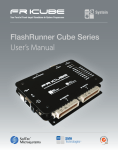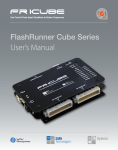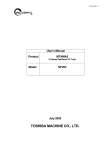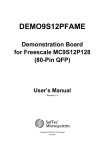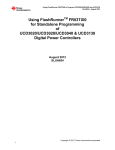Download FlashRunner Quattro User`s Manual
Transcript
FlashRunner Quattro Series High-Performance, Standalone Gang In-System Programmers User’s Manual Revision 1.0 — November 2009 Copyright © 2009 SMH Technologies DC10135 We want your feedback! SMH Technologies is always on the lookout for new ways to improve its Products and Services. For this reason feedback, comments, suggestions or criticisms, however small, are always welcome. Our policy at SMH Technologies is to comply with all applicable worldwide safety and EMC/EMI regulations. Our products are certified to comply with the European New Approach Directives and the CE mark is applied on all our products. This product as shipped from the factory has been verified to meet with requirements FCC as a CLASS A product. In a domestic environment, this product may cause radio interference in which case the user may be required to take adequate prevention measures. Attaching additional wiring to this product or modifying the product operation from the factory default as shipped may effect its performance and cause interference with other apparatus in the immediate vicinity. If such interference is detected, suitable mitigating measures should be taken. SMH Technologies E-mail (general information): [email protected] E-mail (technical support): [email protected] Web: http://www.smh-tech.com Important SMH Technologies reserves the right to make improvements to FlashRunner, its documentation and software routines, without notice. Information in this manual is intended to be accurate and reliable. However, SMH Technologies assumes no responsibility for its use; nor for any infringements of rights of third parties which may result from its use. SMH TECHNOLOGIES WILL NOT BE LIABLE FOR DAMAGES RESULTING FROM LOSS OF DATA, PROFITS, USE OF PRODUCTS, OR INCIDENTAL OR CONSEQUENTIAL DAMAGES, EVEN IF ADVISED OF THE POSSIBILITY THEREOF. Trademarks SMH Technologies is the licensee of the SofTec Microsystems trademark. All other product or service names are the property of their respective owners. FlashRunner Quattro User's Manual Contents 0 Before Starting 9 0.1 0.2 0.3 0.4 1 Overview 11 1.1 1.2 1.3 1.4 1.5 2 Important Notice to Users 9 Safety 9 Getting Technical Support 10 Additional Documentation 10 What is FlashRunner Quattro? 11 1.1.1 General features 12 1.1.2 Hardware features 13 1.1.3 Software features 13 Package Checklist 14 Hardware Overview 14 1.3.1 Power Supply 14 1.3.2 LAN Connector 14 1.3.3 LAN Reset Push-Button 14 1.3.4 RS-232 Connector 15 1.3.5 Control Connector 15 1.3.6 ISP Connectors 15 Programming Algorithms and Licenses 15 1.4.1 Installing New Licenses 15 Upgrading the Firmware 16 System Setup 17 2.1 2.2 2.3 Overview 17 Software Setup 17 Hardware Setup 18 2.3.1 Interfacing FlashRunner with your Test/Programming Equipment 18 2.3.2 Connecting FlashRunner to the Host PC System 19 Contents 2.4 3 Connectors 27 3.1 3.2 3.3 3.4 4 2.3.3 Powering Up FlashRunner 19 2.3.4 Setting Up LAN Settings 19 Step-by-Step Tutorial: Sending Commands to FlashRunner 19 Overview 27 ISP Connectors 27 Control Connector 33 RS-232 Connector 35 Technical Specifications 37 4.1 4.2 4.3 4.4 4.5 Absolute Maximum Ratings 37 DC Characteristics and Functional Operating Range 37 AC Characteristics 39 Multiplexing Characteristics 40 Physical and Environmental Specifications 41 FlashRunner Quattro User's Manual Index of Figures Figure 1.1: FlashRunner Quattro 11 Figure 2.1: FlashRunner Control Panel, Communication Settings 21 Figure 2.2: FlashRunner Control Panel, Target Device Configured 22 Figure 2.3: FlashRunner Control Panel, Binary File Conversion 23 Figure 2.4: FlashRunner Control Panel, File Transfer 24 Figure 2.5: FlashRunner Control Panel, Target Device Programmed 25 Figure 3.1: ISP GROUP Connectors 28 Figure 3.2: Control Connector 33 Figure 3.3: RS-232 Connector 35 Figure 4.1: Load Conditions 40 FlashRunner Quattro User's Manual Index of Tables Table 3.1: ISP GROUP A Connector Signals 28 Table 3.2: ISP GROUP B Connector Signals 30 Table 3.3: Control Connector Signals 33 Table 3.4: RS-232 Connector Signals 35 Table 4.1: Absolute Maximum Ratings 37 Table 4.2: DC Characteristics and Functional Operating Range 37 Table 4.3: AC Characteristics 39 Table 4.4: Multiplexing Characteristics (FR04A08) 40 Table 4.5: Multiplexing Characteristics FR04A16) 40 Table 4.5: Physical and Environmental Specifications 41 FlashRunner Quattro User's Manual 0 0 Before Starting i Note: the FlashRunner System Software CD-ROM and/or SMH Technologies website (www.smh-tech.com) may contain an updated version of this user’s manual. Please check before continuing reading this documentation. 0.1 Important Notice to Users While every effort has been made to ensure the accuracy of all information in this document, SMH Technologies assumes no liability to any party for any loss or damage caused by errors or omissions or by statements of any kind in this document, its updates, supplements, or special editions, whether such errors are omissions or statements resulting from negligence, accidents, or any other cause. 0.2 Safety FlashRunner is a low-voltage device. However, when integrating it inside an automatic test equipment or when interfacing it with other systems, take all precautions in order to avoid electrical shocks due to, for example, different ground references. Make all connections to the target system before applying power to the instrument. To protect FlashRunner against electrostatic discharge (ESD), always connect yourself to ground (e.g. via wrist straps) when handling the instrument. Always store FlashRunner inside an antistatic bag when not in use. 9 Before Starting 0 0.3 Getting Technical Support SMH Technologies is continuously working to improve FlashRunner firmware and to release programming algorithms for new devices. SMH Technologies offers a fast and knowledgeable technical support to all of its customers and is always available to solve specific problems or meet specific needs. To get in touch with SMH Technologies, please refer to the contact information below. Phone: +39 0434 421111 Fax: +39 0434 639021 Technical Support: [email protected] 0.4 Additional Documentation This user’s manual provides information about how to setup FlashRunner Quattro and its hardware characteristics. For information about FlashRunner commands and their syntax, including specific commands for specific family of microcontrollers, please refer to the FlashRunner Programmer’s Manual, included (in PDF format) in the FlashRunner CD-ROM. 10 FlashRunner Quattro User's Manual 1 Overview 1 1.1 What is FlashRunner Quattro? FlashRunner Quattro is a high-integration in-system gang programmer, based on the FlashRunner patented technology. FlashRunner Quattro is designed for programming multi-PCB panel assemblies, and is based on the FlashRunner technology. This means: Extremely fast programming (it is one of the fastest in-system programming system on the market); Standalone operations (projects and code images stored on memory cards); Compact and robust design for production environments. Figure 1.1: FlashRunner Quattro 11 Overview 1 FlashRunner Quattro is composed of a mainboard which hosts the programming and demultiplexing modules, plus various connectors used to interface to the target system and host/ATE. FlashRunner Quattro is available in three different models, to best suit different gang programming needs: FR04A04: 4 ISP channels system (4 true parallel channels), no ISP channel demultiplexing; FR04A08: 8 ISP channels system (4 parallel channels, each demultiplexable to 2 channels, with galvanic isolation); FR04A16: 16 ISP channels system (4 parallel channels, each demultiplexable to 4 channels). In all of the above configurations, each of the ISP channels is composed of: Six digital, bidirectional lines; Two analog/digital lines (analog out, digital in/out); Two power lines; One ground line (common for all channels). 1.1.1 General features Fastest programming algorithms (as fast as target device’s memory technology limit), approved by silicon manufacturers; Easy ATE integration; Standalone operations (projects and code images stored on memory cards); Controllable by ATE through optoisolated LAN, RS-232 or parallel control lines; Supports most ISP protocols (BDM, JTAG, SPI, I2C, MON, ICC, SCI, etc.); Flexible, fully configurable; Compact and robust design for production environments; Data integrity guaranteed (every data transfer to/from the host system or Secure Digital card is CRC tagged). 12 FlashRunner Quattro User's Manual 1.1.2 Hardware features 9 to 18V power supply input; ISP lines: Six digital I/O lines; Two digital I/O or analog output lines; Two programmable output voltages; One programmable clock output Secure Digital memory cards (up to 2 GB); 512 bytes on-board dynamic memory; On-board timekeeper and calendar for time-stamped log file; Three optoisolated command inputs (START, STOP, RELAY); Three optoisolated status outputs (FAIL, PASS, BUSY); Five project selection lines (SEL[4..0]); Optoisolated RS-232/Ethernet channels. 1 1.1.3 Software features Fully autonomous standalone mode thanks to its SD memory cards (FAT16); Controllable by any host system through a terminal utility and simple ASCII protocol; Up to 32 hardware-selectable projects (scripts), unlimited softwareselectable projects; Interface Library DLL to control the instrument from within user written applications; Optional Data Protection System to make the contents of the binary file to be programmed to the target device not readable (and not duplicable) by non-authorized people; Log files; Erase, blank check, program, read, verify, oscillator trimming, etc. 13 Overview 1.2 Package Checklist 1 The FlashRunner Quattro package includes the following items: FlashRunner Quattro unit, including SD cards already pre-installed with the programming algorithm(s) you specified at the time of purchase; An Ethernet cross cable; A RS-232 cable; FlashRunner “System Software” CD-ROM, containing the FlashRunner Control Panel utility and the FlashRunner Programmer’s Manual in PDF format; This user’s manual; A registration card. 1.3 Hardware Overview FlashRunner Quattro is composed of four, independent programming modules (each one with its one SD card) and four multiplexing modules (each one dedicated to the relative programming modules). 1.3.1 Power Supply FlashRunner Quattro is powered through a 9-18V DC terminal block connector. 1.3.2 LAN Connector The LAN connector is used for communication with the host PC system. Use the provided Ethernet cross cable to connect FlashRunner with your PC. 1.3.3 LAN Reset Push-Button The “LAN RESET” resets the instruments’ IP address to its factory programmed value. 14 FlashRunner Quattro User's Manual 1.3.4 RS-232 Connector Alternatively, communication with the host PC can be done with the RS-232 connector. Use the provided serial cable to connect FlashRunner with your PC. 1.3.5 Control Connector The “CONTROL” DIN connector groups the parallel control lines that an ATE system can use to control FlashRunner, instead of communicating with the instrument through the serial or Ethernet port. 1.3.6 ISP Connectors The “ISP GROUP A” and “ISP GROUP B” DIN connectors group the input lines from the ATE system and the ISP output lines from FlashRunner. 1.4 Programming Algorithms and Licenses FlashRunner Quattro includes programming algorithms for several devices. In order to program a specific device, however, a specific license file for that device must be purchased. i Note: FlashRunner Quattro comes already preinstalled with the license(s) you specified at the moment of purchase. You can purchase additional licenses at any future moment. Programming algorithms and license files are stored in the SD card (see the FlashRunner Programmer’s Manual for more information). 1.4.1 Installing New Licenses When you buy an additional license for a specific device, you will get: 15 1 Overview 1 An algorithm file (.alg); A license file (.lic); A device-specific script example (.frs). The .alg file contains the actual programming algorithm for the requested device (and several other devices of the same family). The .lic file contains an unlocking code that will let you use the programming algorithm. A license file enables the use of a specific programming algorithm on a specific FlashRunner instrument (licenses are serial number specific). The script file contains an example of script to use as a starting point for your specific programming needs (for more information on scripts, see the FlashRunner Programmer’s Manual). To install the new license, do the following (for each programming module): 1. 2. Copy the .alg file into the \ALGOS directory of the SD card (if an .alg file with the same name already exists, overwrite it); Copy the .lic file into the \LICENSES directory of the SD card. To copy files on the SD card, use either a standard card reader connected to a PC or transfer the files using the FlashRunner FSSENDFILE command (for more information on FlashRunner commands, see the FlashRunner Programmer’s Manual). Alternatively, you can use the FlashRunner Control Panel utility to install new programming algorithms and licenses. For more information on the FlashRunner Control Panel please refer to the FlashRunner Programmer’s Manual. 1.5 Upgrading the Firmware The FlashRunner firmware can be easily upgraded using the provided Control Panel utility. For more information, please refer to the FlashRunner Programmer’s Manual. 16 FlashRunner Quattro User's Manual 2 System Setup 2.1 Overview i Note: the example shows how to set up the system for programming a Freescale MC68HC908QY4 microcontroller. For how to connect to other target devices, please refer to the FlashRunner Programmer’s Manual. This chapter will explain how to set up FlashRunner Quattro for the first time. Although FlashRunner is typically used for standalone operations (Standalone mode), the examples in this chapter will use the host system to send commands to FlashRunner (Host mode). When moving FlashRunner to the production environment, you can take full advantage of the instrument’s SD cards to make the instrument work without being controlled by the host system. For more information about Standalone mode and Host mode, see the FlashRunner Programmer’s Manual. 2.2 Software Setup The FlashRunner system software setup installs all of the required components to your hard drive. These components include: The FlashRunner Control Panel utility; Script examples; Documentation in PDF format. To install the FlashRunner system software: 17 2 System Setup Insert the “System Software” CD-ROM into your computer’s CD-ROM drive; A startup window will automatically appear. Choose “Install Instrument Software” from the main menu. Follow the on-screen instructions. 2 i Note: to install the FlashRunner system software on Windows 2000 or Windows XP, you must log in as Administrator. 2.3 Hardware Setup To set up FlashRunner Quattro, you must follow the steps below, in the indicated order: 1. 2. 3. 4. 5. Interface FlashRunner with your test/programming equipment; Connect FlashRunner to the host PC system; Power up FlashRunner; Set up LAN settings (if you use the Ethernet connection); Send FlashRunner commands via the FlashRunner Control Panel utility. 2.3.1 Interfacing FlashRunner with your Test/Programming Equipment Build one or more ISP cables to connect from the FlashRunner’s “ISP GROUP” connectors to your target board(s). Make all the required connections (power, oscillator, ISP signals) to the target microcontrollers. Typical connections for all the device families supported by FlashRunner are shown in the FlashRunner Programmer’s Manual. 18 FlashRunner Quattro User's Manual 2.3.2 Connecting FlashRunner to the Host PC System You can connect FlashRunner to the host system through either the RS-232 or LAN port. Both the serial and LAN connectors are located in the Connection layer. FlashRunner Quattro comes with a serial cable and an Ethernet cross cable to connect directly to a host PC. 2.3.3 Powering Up FlashRunner Power up FlashRunner by connecting the output of a power supply to the terminal block connector located in the Connection layer. FlashRunner accepts any DC voltage between 9V and 18V. 2.3.4 Setting Up LAN Settings If you connected FlashRunner to the host PC using the Ethernet connection, you need to set up the FlashRunner IP address. For learning how to set up the FlashRunner IP address, please refer to the FlashRunner Programmer’s Manual. 2.4 Step-by-Step Tutorial: Sending Commands to FlashRunner After setting up the hardware, you are ready to send commands to the instrument. The following steps will guide you through the process of launching your first FlashRunner commands using the provided FlashRunner Control Panel utility. For detailed information about the FlashRunner Control Panel utility, see the FlashRunner Programmer’s Manual. i Note: the following steps show how to program a Freescale MC68HC908QY4 microcontroller, and the details are therefore specific for that microcontroller. However, the procedures shown are general and will allow you get a feel of how FlashRunner works. 19 2 System Setup 1. 2. 2 Launch the FlashRunner Control Panel utility. Select Start > Programs > SofTec Microsystems > FlashRunner > Control Panel. The Control Panel utility will open. To establish a connection with FlashRunner, on the “Communication Settings” section, select: “FlashRunner serial version” (if you are connected to FlashRunner through a serial port), or “FlashRunner LAN version” (if you are connected to FlashRunner through an Ethernet port). Next, specify: The COM port you are using and the baud rate (for the serial connection—by default, FlashRunner communicates at 115200 bps), or The instrument IP address (for the Ethernet connection). For learning how to set up the FlashRunner IP address, please refer to the FlashRunner Programmer’s Manual. 20 FlashRunner Quattro User's Manual 2 Figure 2.1: FlashRunner Control Panel, Communication Settings 3. Click the “Connect” button. On the “Communication History” section, note the commands that have been sent and received. In this case, the MCSPING command is automatically sent to FlashRunner, which replies with the PONG> string. 4. In the edit box below the communication history, type the following command (followed by Return): MCSETENG ENG1 5. This commands instructs the instrument to send all subsequent commands to the first programming module. Send the following additional commands: TCSETDEV FREESCALE MC68HC908QY4 HC08 TCSETPAR FOSC 16000000 21 System Setup TCSETPAR FDIV 4 TCSETPAR VDD 5000 These commands set, respectively, the target microcontroller, the oscillator frequency, the internal divisor and the VDD voltage. In this example, we used a 16 MHz oscillator, the internal divisor for MC68HC908QY4 devices is fixed to 4, and the VDD is 5V. FlashRunner will respond to each command with the > string, indicating that the command has been successfully executed. After sending these commands, the Control Panel will look like the figure below. 2 Figure 2.2: FlashRunner Control Panel, Target Device Configured 6. 22 When working with Freescale HC08 devices, FlashRunner requires you to specify the power up and power down times, in milliseconds. Send the following two commands: FlashRunner Quattro User's Manual TCSETPAR PWDOWN 10 TCSETPAR PWUP 10 7. After specifying the target device settings, we are ready to transfer to FlashRunner the binary image to be programmed into the target device. FlashRunner accepts only image files in a .frb (FlashRunner Binary) format. To convert your binary, Intel-Hex or S19 image file to the FlashRunner format, click the “Create FlashRunner Binary Format” button. The following dialog box will appear. Figure 2.3: FlashRunner Control Panel, Binary File Conversion In the “Input” section, specify the source file to be converted, its format, and the address from which the file conversion will start (offset). In the “Output” section, specify the output filename and the value used to fill unused locations. Click the “OK” button. The FlashRunner Binary file will be created in the local \BINARIES folder. 8. To transfer the created image to selected programming module, send the following command: FSSENDFILE YMODEM DEMO.FRB In this example, the image file is called DEMO.FRB. The following dialog box will appear. 23 2 System Setup 2 Figure 2.4: FlashRunner Control Panel, File Transfer Click the “...” button to browse for the image file to be send, then click “Start” to begin the transfer. The file will be saved to the SD card of the selected programming module, in the \BINARIES folder. 9. (Only for FR04A08 and FR04A16) Next, we have to specify which of available ISP sites (for the selected programming module, in this case the first one) FlashRunner will use as output. To do this, send the following command: MXCLOSE 1 This will select the first ISP site, routing all of the FlashRunner’s ISP lines of the first programming module to the target board through this site. 10. We are now ready to start the actual programming part. Send the following commands: TPSETSRC FILE DEMO.FRB TPSTART TPCMD SETPWD CONST $FF $FF $FF $FF $FF $FF $FF $FF TPCMD MASSERASE F TPCMD BLANKCHECK F $EE00 4608 TPCMD PROGRAM F $EE00 $EE00 4608 TPCMD VERIFY F S $EE00 $EE00 4608 TPEND 24 FlashRunner Quattro User's Manual The data to be programmed is taken from the image file starting at $EE00 (offset from the beginning of the file), is programmed to the target microcontroller starting from the location $EE00 and is 4608 bytes long. The TPSETSRC command specifies the source file for the TPCMD PROGRAM e TPCMD VERIFY commands that come next. All the actual programming operations are sent between a TPSTART and TPEND command. The TPCMD SETPWD command sets the security bytes needed to perform subsequent operations. After sending these commands, the Control Panel will look like the figure below. Figure 2.5: FlashRunner Control Panel, Target Device Programmed 11. We are now done with programming the target device. Click the “Disconnect” button to free the serial port resource. 25 2 System Setup 2 For detailed information on all of the FlashRunner commands and their syntax, including specific commands for specific family of microcontrollers, please refer to the FlashRunner Programmer’s Manual, included (in PDF format) in the FlashRunner CD-ROM. Programming can be automated by creating “scripts”. Scripts are text files, stored in the SD cards, which contain a sequence of FlashRunner commands. See the FlashRunner Programmer’s Manual for more information about scripts. 26 FlashRunner Quattro User's Manual 3 Connectors 3.1 Overview FlashRunner Quattro connects to your programming/testing system through three connectors: two connectors (“ISP GROUP A” and “ISP GROUP B”) group the outputs from FlashRunner; the other connector (“CONTROL”) groups control signals. Additionally, an RS-232 and Ethernet connector are provided for full interfacing with the ATE system. 3.2 ISP Connectors The “ISP GROUP A” and “ISP GROUP B” connectors group the signals needed to program up to 16 target devices (depending on the FlashRunner Quattro model). These connectors have several input/output lines, both digital and analog, that are automatically configured by FlashRunner depending on the specific target device to be programmed (see the FlashRunner Programmer’s Manual to learn how to connect these lines to your specific target device). ! Note: ISP and I/O signals are not optoisolated and are referenced to GND (the power supply ground). Additionally, in order to avoid undesired current loops between the FlashRunner power supply and the target board, a power supply with a floating output (ground not referenced to the earth potential) should be used. 27 3 Connectors C1 B1 A1 “ISP GROUP” Connector Figure 3.1: ISP GROUP Connectors 3 Table 3.1: ISP GROUP A Connector Signals Pin # Signal Name Description A1 1DIO0/AO0 ISP Site 1: Digital input/output 0 or analog output 0 A2 1DIO3 ISP Site 1: Digital input/output 3 A3 1DIO6 ISP Site 1: Digital input/output 6 A4 1VPROG0 ISP Site 1: Programmable voltage 0 A5 2DIO0/AO0 ISP Site 2: Digital input/output 0 or analog output 0 A6 2DIO3 ISP Site 2: Digital input/output 3 A7 2DIO6 ISP Site 2: Digital input/output 6 A8 2VPROG0 ISP Site 2: Programmable voltage 0 A9 3DIO0/AO0 ISP Site 3: Digital input/output 0 or analog output 0 A10 3DIO3 ISP Site 3: Digital input/output 3 A11 3DIO6 ISP Site 3: Digital input/output 6 A12 3VPROG0 ISP Site 3: Programmable voltage 0 A13 4DIO0/AO0 ISP Site 4: Digital input/output 0 or analog output 0 A14 4DIO3 ISP Site 4: Digital input/output 3 A15 4DIO6 ISP Site 4: Digital input/output 6 A16 4VPROG0 ISP Site 4: Programmable voltage 0 A17 5DIO0/AO0 ISP Site 5: Digital input/output 0 or analog output 0 A18 5DIO3 ISP Site 5: Digital input/output 3 A19 5DIO6 ISP Site 5: Digital input/output 6 A20 5VPROG0 ISP Site 5: Programmable voltage 0 A21 6DIO0/AO0 ISP Site 6: Digital input/output 0 or analog output 0 A22 6DIO3 ISP Site 6: Digital input/output 3 A23 6DIO6 ISP Site 6: Digital input/output 6 A24 6VPROG0 ISP Site 6: Programmable voltage 0 A25 7DIO0/AO0 ISP Site 7: Digital input/output 0 or analog output 0 A26 7DIO3 ISP Site 7: Digital input/output 3 A27 7DIO6 ISP Site 7: Digital input/output 6 A28 7VPROG0 ISP Site 7: Programmable voltage 0 A29 8DIO0/AO0 ISP Site 8: Digital input/output 0 or analog output 0 28 FlashRunner Quattro User's Manual Pin # Signal Name Description A30 8DIO3 ISP Site 8: Digital input/output 3 A31 8DIO6 ISP Site 8: Digital input/output 6 A32 8VPROG0 ISP Site 8: Programmable voltage 0 B1 1DIO1/AO1 ISP Site 1: Digital input/output 1 or analog output 1 B2 1DIO4 ISP Site 1: Digital input/output 4 B3 GND Ground B4 1VPROG1 ISP Site 1: Programmable voltage 1 B5 2DIO1/AO1 ISP Site 2: Digital input/output 1 or analog output 1 B6 2DIO4 ISP Site 2: Digital input/output 4 B7 GND Ground B8 2VPROG1 ISP Site 2: Programmable voltage 1 B9 3DIO1/AO1 ISP Site 3: Digital input/output 1 or analog output 1 B10 3DIO4 ISP Site 3: Digital input/output 4 B11 GND Ground B12 3VPROG1 ISP Site 3: Programmable voltage 1 B13 4DIO1/AO1 ISP Site 4: Digital input/output 1 or analog output 1 B14 4DIO4 ISP Site 4: Digital input/output 4 B15 GND Ground B16 4VPROG1 ISP Site 4: Programmable voltage 1 B17 5DIO1/AO1 ISP Site 5: Digital input/output 1 or analog output 1 B18 5DIO4 ISP Site 5: Digital input/output 4 B19 GND Ground B20 5VPROG1 ISP Site 5: Programmable voltage 1 B21 6DIO1/AO1 ISP Site 6: Digital input/output 1 or analog output 1 B22 6DIO4 ISP Site 6: Digital input/output 4 B23 GND Ground B24 6VPROG1 ISP Site 6: Programmable voltage 1 B25 7DIO1/AO1 ISP Site 7: Digital input/output 1 or analog output 1 B26 7DIO4 ISP Site 7: Digital input/output 4 B27 GND Ground B28 7VPROG1 ISP Site 7: Programmable voltage 1 B29 8DIO1/AO1 ISP Site 8: Digital input/output 1 or analog output 1 B30 8DIO4 ISP Site 8: Digital input/output 4 B31 GND Ground B32 8VPROG1 ISP Site 8: Programmable voltage 1 C1 1DIO2 ISP Site 1: Digital input/output 2 C2 1DIO5 ISP Site 1: Digital input/output 5 C3 1CLKOUT ISP Site 1: Clock output C4 GND Ground C5 2DIO2 ISP Site 2: Digital input/output 2 C6 2DIO5 ISP Site 2: Digital input/output 5 C7 2CLKOUT ISP Site 2: Clock output 3 29 Connectors 3 Pin # Signal Name Description C8 GND Ground C9 3DIO2 ISP Site 3: Digital input/output 2 C10 3DIO5 ISP Site 3: Digital input/output 5 C11 3CLKOUT ISP Site 3: Clock output C12 GND Ground C13 4DIO2 ISP Site 4: Digital input/output 2 C14 4DIO5 ISP Site 4: Digital input/output 5 C15 4CLKOUT ISP Site 4: Clock output C16 GND Ground C17 5DIO2 ISP Site 5: Digital input/output 2 C18 5DIO5 ISP Site 5: Digital input/output 5 C19 5CLKOUT ISP Site 5: Clock output C20 GND Ground C21 6DIO2 ISP Site 6: Digital input/output 2 C22 6DIO5 ISP Site 6: Digital input/output 5 C23 6CLKOUT ISP Site 6: Clock output C24 GND Ground C25 7DIO2 ISP Site 7: Digital input/output 2 C26 7DIO5 ISP Site 7: Digital input/output 5 C27 7CLKOUT ISP Site 7: Clock output C28 GND Ground C29 8DIO2 ISP Site 8: Digital input/output 2 C30 8DIO5 ISP Site 8: Digital input/output 5 C31 8CLKOUT ISP Site 8: Clock output C32 GND Ground Table 3.2: ISP GROUP B Connector Signals Pin # Signal Name Description A1 9DIO0/AO0 ISP Site 9: Digital input/output 0 or analog output 0 A2 9DIO3 ISP Site 9: Digital input/output 3 A3 9DIO6 ISP Site 9: Digital input/output 6 A4 9VPROG0 ISP Site 9: Programmable voltage 0 A5 10DIO0/AO0 ISP Site 10: Digital input/output 0 or analog output 0 A6 10DIO3 ISP Site 10: Digital input/output 3 A7 10DIO6 ISP Site 10: Digital input/output 6 A8 10VPROG0 ISP Site 10: Programmable voltage 0 A9 11DIO0/AO0 ISP Site 11: Digital input/output 0 or analog output 0 A10 11DIO3 ISP Site 11: Digital input/output 3 A11 11DIO6 ISP Site 11: Digital input/output 6 A12 11VPROG0 ISP Site 11: Programmable voltage 0 30 FlashRunner Quattro User's Manual Pin # Signal Name Description A13 12DIO0/AO0 ISP Site 12: Digital input/output 0 or analog output 0 A14 12DIO3 ISP Site 12: Digital input/output 3 A15 12DIO6 ISP Site 12: Digital input/output 6 A16 12VPROG0 ISP Site 12: Programmable voltage 0 A17 13DIO0/AO0 ISP Site 13: Digital input/output 0 or analog output 0 A18 13DIO3 ISP Site 13: Digital input/output 3 A19 13DIO6 ISP Site 13: Digital input/output 6 A20 13VPROG0 ISP Site 13: Programmable voltage 0 A21 14DIO0/AO0 ISP Site 14: Digital input/output 0 or analog output 0 A22 14DIO3 ISP Site 14: Digital input/output 3 A23 14DIO6 ISP Site 14: Digital input/output 6 A24 14VPROG0 ISP Site 14: Programmable voltage 0 A25 15DIO0/AO0 ISP Site 15: Digital input/output 0 or analog output 0 A26 15DIO3 ISP Site 15: Digital input/output 3 A27 15DIO6 ISP Site 15: Digital input/output 6 A28 15VPROG0 ISP Site 15: Programmable voltage 0 A29 16DIO0/AO0 ISP Site 16: Digital input/output 0 or analog output 0 A30 16DIO3 ISP Site 16: Digital input/output 3 A31 16DIO6 ISP Site 16: Digital input/output 6 A32 16VPROG0 ISP Site 16: Programmable voltage 0 B1 9DIO1/AO1 ISP Site 9: Digital input/output 1 or analog output 1 B2 9DIO4 ISP Site 9: Digital input/output 4 B3 GND Ground B4 9VPROG1 ISP Site 9: Programmable voltage 1 B5 10DIO1/AO1 ISP Site 10: Digital input/output 1 or analog output 1 B6 10DIO4 ISP Site 10: Digital input/output 4 B7 GND Ground B8 10VPROG1 ISP Site 10: Programmable voltage 1 B9 11DIO1/AO1 ISP Site 11: Digital input/output 1 or analog output 1 B10 11DIO4 ISP Site 11: Digital input/output 4 B11 GND Ground B12 11VPROG1 ISP Site 11: Programmable voltage 1 B13 12DIO1/AO1 ISP Site 12: Digital input/output 1 or analog output 1 B14 12DIO4 ISP Site 12: Digital input/output 4 B15 GND Ground B16 12VPROG1 ISP Site 12: Programmable voltage 1 B17 13DIO1/AO1 ISP Site 13: Digital input/output 1 or analog output 1 B18 13DIO4 ISP Site 13: Digital input/output 4 B19 GND Ground B20 13VPROG1 ISP Site 13: Programmable voltage 1 B21 14DIO1/AO1 ISP Site 14: Digital input/output 1 or analog output 1 B22 14DIO4 ISP Site 14: Digital input/output 4 3 31 Connectors 3 Pin # Signal Name Description B23 GND Ground B24 14VPROG1 ISP Site 14: Programmable voltage 1 B25 15DIO1/AO1 ISP Site 15: Digital input/output 1 or analog output 1 B26 15DIO4 ISP Site 15: Digital input/output 4 B27 GND Ground B28 15VPROG1 ISP Site 15: Programmable voltage 1 B29 16DIO1/AO1 ISP Site 16: Digital input/output 1 or analog output 1 B30 16DIO4 ISP Site 16: Digital input/output 4 B31 GND Ground B32 16VPROG1 ISP Site 16: Programmable voltage 1 C1 9DIO2 ISP Site 9: Digital input/output 2 C2 9DIO5 ISP Site 9: Digital input/output 5 C3 9CLKOUT ISP Site 9: Clock output C4 GND Ground C5 10DIO2 ISP Site 10: Digital input/output 2 C6 10DIO5 ISP Site 10: Digital input/output 5 C7 10CLKOUT ISP Site 10: Clock output C8 GND Ground C9 11DIO2 ISP Site 11: Digital input/output 2 C10 11DIO5 ISP Site 11: Digital input/output 5 C11 11CLKOUT ISP Site 11: Clock output C12 GND Ground C13 12DIO2 ISP Site 12: Digital input/output 2 C14 12DIO5 ISP Site 12: Digital input/output 5 C15 12CLKOUT ISP Site 12: Clock output C16 GND Ground C17 13DIO2 ISP Site 13: Digital input/output 2 C18 13DIO5 ISP Site 13: Digital input/output 5 C19 13CLKOUT ISP Site 13: Clock output C20 GND Ground C21 14DIO2 ISP Site 14: Digital input/output 2 C22 14DIO5 ISP Site 14: Digital input/output 5 C23 14CLKOUT ISP Site 14: Clock output C24 GND Ground C25 15DIO2 ISP Site 15: Digital input/output 2 C26 15DIO5 ISP Site 15: Digital input/output 5 C27 15CLKOUT ISP Site 15: Clock output C28 GND Ground C29 16DIO2 ISP Site 16: Digital input/output 2 C30 16DIO5 ISP Site 16: Digital input/output 5 C31 16CLKOUT ISP Site 16: Clock output C32 GND Ground 32 FlashRunner Quattro User's Manual 3.3 Control Connector The “CONTROL” D-Sub connector is used to communicate with the host system and for integration with automatic programming/testing equipment. i Note: all control signals are referenced to GND_I, separate from GND. This allows a host system to safely communicate with FlashRunner Quattro even when the target board has a different ground reference than the host system’s (and it’s not possible to connect them together). Additionally, in order to avoid undesired current loops between the FlashRunner power supply and the target board, a power supply with a floating output (ground not referenced to the earth potential) should be used. 3 C1 B1 A1 “CONTROL” Connector Figure 3.2: Control Connector Table 3.3: Control Connector Signals Pin # Signal Name Description A1 SEL0 Script selection 0 (input, referenced to GND_I) A2 SEL1 Script selection 1 (input, referenced to GND_I) A3 SEL2 Script selection 2 (input, referenced to GND_I) A4 SEL3 Script selection 3 (input, referenced to GND_I) A5 SEL4 Script selection 4 (input, referenced to GND_I) A6 SG0 ISP site selection 0 (input, referenced to GND_I) A7 SG1 ISP site selection 1 (input, referenced to GND_I) A8 5V_I_FUSE 5V output (output, fuse-protected, referenced to GND_I) 33 Connectors 3 Pin # Signal Name Description A9 GND_I Ground A10 GND_I Ground A11 GND_I Ground A12 GND_I Ground A13 GND_I Ground A14 GND_I Ground A15 GND_I Ground A16 GND_I Ground B1 START1 Programming module 1 START (input , referenced to GND_I, active low) B2 BUSY1 Programming module 1 BUSY (output, referenced to GND_I, active low) B3 PASS1 Programming module 1 PASS (output , referenced to GND_I, active low) B4 FAIL1 Programming module 1 FAIL (output , referenced to GND_I, active low) B5 5V_I_FUSE 5V output (output, fuse-protected, referenced to GND_I) B6 GND_I Ground B7 GND_I Ground B8 GND_I Ground B9 GND_I Ground B10 GND_I Ground B11 GND_I Ground B12 START2 Programming module 2 START (input , referenced to GND_I, active low) B13 BUSY2 Programming module 2 BUSY (output, referenced to GND_I, active low) B14 PASS2 Programming module 2 PASS (output , referenced to GND_I, active low) B15 FAIL2 Programming module 2 FAIL (output , referenced to GND_I, active low) B16 5V_I_FUSE 5V output (output, fuse-protected, referenced to GND_I) C1 START3 Programming module 3 START (input , referenced to GND_I, active low) C2 BUSY3 Programming module 3 BUSY (output, referenced to GND_I, active low) C3 PASS3 Programming module 3 PASS (output , referenced to GND_I, active low) C4 FAIL3 Programming module 3 FAIL (output , referenced to GND_I, active low) C5 5V_I_FUSE 5V output (output, fuse-protected, referenced to GND_I) C6 GND_I Ground C7 GND_I Ground C8 GND_I Ground C9 GND_I Ground C10 GND_I Ground C11 GND_I Ground C12 START4 Programming module 4 START (input , referenced to GND_I, active low) C13 BUSY4 Programming module 4 BUSY (output, referenced to GND_I, active low) C14 PASS4 Programming module 4 PASS (output , referenced to GND_I, active low) C15 FAIL4 Programming module 4 FAIL (output , referenced to GND_I, active low) C16 5V_I_FUSE 5V output (output, fuse-protected, referenced to GND_I) 34 FlashRunner Quattro User's Manual 3.4 RS-232 Connector The “RS-232” D-Sub connector can be used to communicate with the ATE system. i Note: RS-232 signals are referenced to GND_I, separate from GND. 3 NC 1 TX_RS232 2 RX_RS232 3 NC 4 GND_I 5 6 NC 7 NC 8 NC 9 NC 1µF “RS-232” Connector GND_I Figure 3.3: RS-232 Connector Table 3.4: RS-232 Connector Signals Pin # Signal Name Description 1 NC Not connected 2 TX_RS232 TX (output, referenced to GND_I, RS-232 levels) 3 RX_RS232 RX (input, referenced to GND_I, RS-232 levels) 4 NC Not connected 5 GND_I Ground 6 NC Not connected 7 NC Not connected 8 NC Not connected 9 NC Not connected 35 FlashRunner Quattro User's Manual 4 Technical Specifications 4.1 Absolute Maximum Ratings Table 4.1: Absolute Maximum Ratings Parameter Value “POWER” Connector Maximum supply voltage on line POWER (reference GND) -20V to +20V “CONTROL” Connector Maximum input voltage on lines START, SEL[4..0], SG[1..0] -2V to +20V Maximum current on lines BUSY, PASS, FAIL ±10mA 4 “ISP GROUP” Connectors Maximum input voltage on lines DIO/AO[1..0], DIO[6..2], CLKOUT -1V to +7V Maximum current on lines DIO/AO[1..0], DIO[6..2], CLKOUT ±50mA Maximum current on line VPROG0 500mA Maximum current on line VPROG1 250mA “RS-232” Connector Maximum input voltage on line RX_RS232 -25V to +25V Maximum current on line TX_RS232 ±60mA 4.2 DC Characteristics and Functional Operating Range Table 4.2: DC Characteristics and Functional Operating Range Parameter Value Condition Min Typ Max VIL (input low voltage) on lines START, SEL[4..0] 0V - 0.8V VIH (input high voltage) on lines START, SEL[4..0] 2.4V - 15V - - 0.8V “CONTROL” Connector VOL (output low voltage) on lines BUSY, FAIL, PASS IOL = 4mA 37 Technical Specifications Parameter Value Condition Min Typ Max 4.5V - 5V VIL (input low voltage) on line RX_RS232 - - 1.2V VIH (input high voltage) on line RX_RS232 2.4V - - VOH (output high voltage) on lines BUSY, FAIL, PASS “RS-232” Connector VOL (output low voltage) on line TX_RS232 RLOAD = 3KΩ - - -5V VOH (output high voltage) on line TX_RS232 RLOAD = 3KΩ +5V - - “ISP GROUP” Connectors 4 VIL (input low voltage) on lines DIO Configured as digital lines - - 0.3VPROG0 VIH (input high voltage) on lines DIO Configured as digital lines 0.7VPROG0 - VPROG0 VOL (output low voltage) on lines DIO, CLKOUT Configured as digital lines, VPROG0 = 3V, IOL = 12mA - - 0.36V VOH (output high voltage) on lines DIO, CLKOUT Configured as digital lines, VPROG0 = 3V, IOH = 12mA 2.56V - - VOL (output low voltage) on lines DIO, CLKOUT Configured as digital lines, VPROG0 = 5.5V, IOL = 24mA - - 0.36V VOH (output high voltage) on lines DIO, CLKOUT Configured as digital lines, VPROG0 = 5.5V, IOH = 24mA 4.86V - - IOH current (source) on lines DIO Configured as input with active pull-ups - 3.4mA - DIO/AO[1..0] voltage Configured as analog output 0V - 14.5V DIO/AO[1..0] IO current (sink and source) Configured as analog output - - ±40mA IOH current (source) on lines DIO/AO[1..0] Configured as analog lines with active pull-ups - 5.5mA - 1.6V - 5.5V - - 500mA 3.5V - 13V - - 250mA 9V - 18V - - 3.5A VPROG0 output voltage VPROG0 current (source) VPROG1 output voltage VPROG1 current (source) “POWER” Connector Supply voltage Power consumption 38 FlashRunner Quattro User's Manual 4.3 AC Characteristics Table 4.3: AC Characteristics Parameter Value Condition Min Typ Max - 40ns - - 30ns - tRISE on lines DIO[6..2], DIO[1..0], CLKOUT when configured as digital output push-pull VPROG0 = 1.8V VPROG0 = 5V - 25ns - tFALL on lines DIO[6..2], DIO[1..0], CLKOUT when configured as digital output push-pull VPROG0 = 1.8V - 35ns - - 25ns - VPROG0 = 5V - 25ns - VPROG1 = 3V - 7µs - - 11µs - VPROG1 = 14.5V - 12µs - VPROG1 = 3V - 8µs - - 20µs - - 30µs - tRISE on lines DIO/AO[1..0] configured as analog output tFALL on lines DIO/AO[1..0] configured as analog output VPROG0 = 3.3V VPROG0 = 3.3V VPROG1 = 12V VPROG1 = 12V Load: 470Ω//100pF (see figure 4.1a) Load: 470Ω//100pF (see figure 4.1a) Load: 4.7KΩ//100pF (see figure 4.1a) Load: 100pF (see figure 4.1b) VPROG1 = 14.5V tRISE on line VPROG0 VPROG0 = 0-1.8V Load: 15Ω//10mF (see figure 4.1a) - 10ms - VPROG0 = 0-3.3V Load: 22Ω//10mF (see figure 4.1a) - 15ms - VPROG0 = 0-5.5V Load: 22Ω//10mF (see figure 4.1a) - 20ms - - 300ms - - 350ms - VPROG0 = 1.8-0V tFALL on line VPROG0 VPROG0 = 3.3-0V Load: 10mF (see figure 41b) - 350ms - VPROG1 = 0-3V Load: 10Ω//1mF (see figure 4.1a) - 1.3ms - VPROG1 = 0-5V Load: 47Ω//1mF (see figure 4.1a) - 1.8ms - VPROG1 = 0-14.5V Load: 94Ω//1mF (see figure 4.1a) - 13ms - - 18ms - - 30ms - - 45ms - 0MHz - 50MHz VPROG0 = 5.5-0V tRISE on line VPROG1 VPROG1 = 3-0V tFALL on line VPROG1 VPROG1 = 5-0V VPROG1 = 14.5-0V CLKOUT frequency 4 Load: 1mF (see figure 4.1b) 39 Technical Specifications a b FlashRunner FlashRunner R C C Figure 4.1: Load Conditions 4.4 Multiplexing Characteristics Table 4.4: Multiplexing Characteristics (FR04A08) 4 Parameter Value Switch type on lines DIO/AO[1..0], DIO[6..2], CLKOUT Reed Relay Switch type on lines VPROG[1..0] Reed Relay Off resistance on lines DIO/AO[1..0] 1012Ω Typ Off resistance on lines DIO[6..2], CLKOUT 1012Ω Typ Off resistance on lines VPROG[1..0] 1012Ω Typ On resistance on lines DIO/AO[1..0] 100mΩ Max On resistance on lines DIO[6..2], CLKOUT 100mΩ Max On resistance on lines VPROG[1..0] 100mΩ Max Open time 20µs Max Close time 100µs Max Relay life 100mΩ Max Table 4.5: Multiplexing Characteristics FR04A16) Parameter Value Switch type on lines DIO/AO[1..0], DIO[6..2], CLKOUT CMOS Switch type on lines VPROG[1..0] Reed Relay Off resistance on lines DIO/AO[1..0] 29Ω Typ Off resistance on lines DIO[6..2], CLKOUT 159Ω Typ Off resistance on lines VPROG[1..0] 1012Ω Typ On resistance on lines DIO/AO[1..0] 4Ω Typ On resistance on lines DIO[6..2], CLKOUT 2.5Ω Typ On resistance on lines VPROG[1..0] 100mΩ Max Bandwidth on lines DIO/AO[1..0] 120MHz Typ Bandwidth on lines DIO[6..2], CLKOUT 200MHz Typ 40 FlashRunner Quattro User's Manual Open time 20µs Max Close time 100µs Max Relay life on lines DIO/AO[1..0], DIO[6..2], CLKOUT Unlimited Relay life on lines VPROG[1..0] 100MCycles Typ 4.5 Physical and Environmental Specifications Table 4.6: Physical and Environmental Specifications Parameter Value Dimensions, without mounting brackets 165 x 155 x 50 mm Dimensions, without mounting brackets 180 x 155 x 55 mm “ISP GROUP” connectors type 96 way, 3 row, DIN 41612, reverse, pitch = 2.54mm (female) “CONTROL” connector type 48 way, 3 row, DIN 41612, reverse, pitch = 2.54mm (female) “RS-232” connector type 9-pin, 2.54mm-pitch, D-Sub (female) “LAN” connector type RJ-45 connector “POWER” connector type Terminal block connector, pitch = 5.08mm Operating temperature 0-50°C Operating humidity 90% max (without condensation) Storage temperature 0-70°C Storage humidity 90% max (without condensation) 4 41
















































